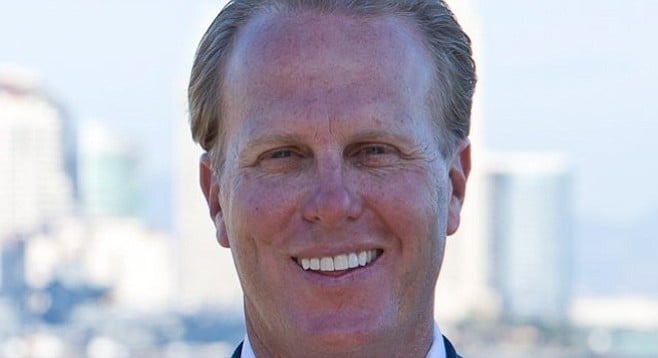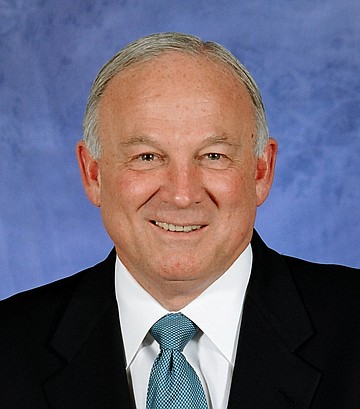 Facebook
Facebook
 X
X
 Instagram
Instagram
 TikTok
TikTok
 Youtube
Youtube

In his state of the city address yesterday evening (January 14), mayor Kevin Faulconer said he wants to repair long-neglected infrastructure, take action on expansion of the convention center, and build a stadium for the Chargers that, he claims, will be fair to taxpayers.
It's not unusual for politicians to present ideas that economically can't happen: dealing with the infrastructure is all the city can afford — if that.
Los Angeles is talking about building a stadium without taxpayer money, but nothing similar will happen in San Diego, particularly since the Spanos family will only put in $200 million. Any stadium will cost $1 billion, and one with a retractable dome, which will supposedly serve as a convention-center expansion, would cost at least $1.5 billion.

The Spanos family's $200 million will most likely include naming and advertising rights; the actual cash outlay could be less than $100 million. An exhaustive study by Judith Grant Long while she was at Harvard showed that the costs of land, infrastructure, operations, and lost property taxes normally add 25 percent to the taxpayers' bill. These costs are generally underestimated by the team and the city. On average, taxpayers pick up 78 percent of the cost, she calculated.

San Diego does not have that kind of money unless taxes are raised sharply or pension benefits of city workers are cut. Independent budget analyst Andrea Tevlin, studying the mayor's financial outlook for 2016–2020, said "the city does not have enough resources to meet all the needs of the community." And she was not assessing costs of a stadium or convention center expansion.
Faulconer said he favors building a stadium at the current Mission Valley site or building one downtown that would double as a convention-center expansion. But there are multiple problems with the Mission Valley site, including the current overcrowding of Mission Valley itself, as well as environmental questions. The hotel industry is split on whether a convention-center expansion should be distant from the current facility. Most hoteliers seem to prefer a structure contiguous to the current center.

Also, both Tevlin (in her December report) and Faulconer are counting on an improving economy. However, this year's volatile stock market and the plunge of key commodity prices such as in oil and copper do not portend a robust American economy. Economists generally predict recessions for Europe, Japan, Russia, and oil-exporting nations.
Faulconer says he will name a group of civic leaders to develop a plan to build a stadium. If past is prologue, those leaders will almost unanimously come from the corporate-welfare crowd that dominated committees named by Faulconer's predecessor, Jerry Sanders.


In his state of the city address yesterday evening (January 14), mayor Kevin Faulconer said he wants to repair long-neglected infrastructure, take action on expansion of the convention center, and build a stadium for the Chargers that, he claims, will be fair to taxpayers.
It's not unusual for politicians to present ideas that economically can't happen: dealing with the infrastructure is all the city can afford — if that.
Los Angeles is talking about building a stadium without taxpayer money, but nothing similar will happen in San Diego, particularly since the Spanos family will only put in $200 million. Any stadium will cost $1 billion, and one with a retractable dome, which will supposedly serve as a convention-center expansion, would cost at least $1.5 billion.

The Spanos family's $200 million will most likely include naming and advertising rights; the actual cash outlay could be less than $100 million. An exhaustive study by Judith Grant Long while she was at Harvard showed that the costs of land, infrastructure, operations, and lost property taxes normally add 25 percent to the taxpayers' bill. These costs are generally underestimated by the team and the city. On average, taxpayers pick up 78 percent of the cost, she calculated.

San Diego does not have that kind of money unless taxes are raised sharply or pension benefits of city workers are cut. Independent budget analyst Andrea Tevlin, studying the mayor's financial outlook for 2016–2020, said "the city does not have enough resources to meet all the needs of the community." And she was not assessing costs of a stadium or convention center expansion.
Faulconer said he favors building a stadium at the current Mission Valley site or building one downtown that would double as a convention-center expansion. But there are multiple problems with the Mission Valley site, including the current overcrowding of Mission Valley itself, as well as environmental questions. The hotel industry is split on whether a convention-center expansion should be distant from the current facility. Most hoteliers seem to prefer a structure contiguous to the current center.

Also, both Tevlin (in her December report) and Faulconer are counting on an improving economy. However, this year's volatile stock market and the plunge of key commodity prices such as in oil and copper do not portend a robust American economy. Economists generally predict recessions for Europe, Japan, Russia, and oil-exporting nations.
Faulconer says he will name a group of civic leaders to develop a plan to build a stadium. If past is prologue, those leaders will almost unanimously come from the corporate-welfare crowd that dominated committees named by Faulconer's predecessor, Jerry Sanders.
Comments